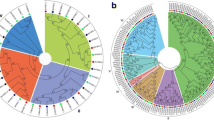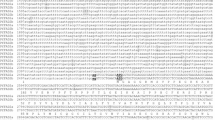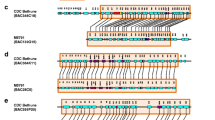Abstract
The fatty acid elongase 1 (FAE1) genes of Brassic napus were cloned from two cultivars, i.e. Zhongshuan No. 9 with low erucic acid content, and Zhongyou 821 with high erucic acid content, using the degenerate PCR primers. The sequence analysis showed that there was no intron within the FAE1 genes. The FAE1 genes from Zhongyou 821 contained a coding sequence of 1521 nucleotides, and those cloned from Zhongshuan No. 9 contained a 1517 bp coding sequence. Alignment of the FAE1 sequences from Brassica rapa, B. oleracea and B. napus detected 31 single nucleotide polymorphic sites (2.03%), which resulted in 7 amino-acid substitutions. Further analysis indicated that 19 SNPs were genome-specific, of which, 95% were synonymous mutations. The nucleotide substitution at position 1217 in the FAE1 genes led to a specific site of restricted cleavage. An AvrII cleavage site was present only in the C genome genes and absent in the A genome FAE1 genes. Digestion profile of the FAE1 sequences from B. rapa, B. oleracea and B. napus produced with AvrII confirmed that the FAE1 genes of B. oleracea origin was recognized and digested, while that of B. rapa origin could not. The results indicated that by AvrII cleavage it was possible to distinguish B. rapa from B. oleracea and between the A and C genome of B. napus. In addition, the FAE1 genes could be used as marker genes to detect the pollen flow of B. napus, thus providing an alternative method for risk assessment of gene flow.
Similar content being viewed by others
References
Liu H L, ed. Rapeseed Genetics and Breeding (in Chinese). Shanghai: Shanghai Scientific and Technology Publishing House, 1985. 159–161
Downey R K, Craig B M. Genetic control of fatty acid biosynthesis in rapeseed (Brassica napus L.). J Am Oil Chem Soc, 1964, 41: 475–478
Anand I J, Downey R K. A study of erucic acid alleles in digenomic rapeseed (Brassica napus L.). Can J Plant Sci, 1981, 61: 199–203
Jönsson R. Erucic-acid heredity in rapeseed (Brassica napus L. and Brassica campestris L.). Hereditas, 1977, 86: 159–170
Stumpf P K, Pollard M R. Pathways of fatty acid biosynthesis in higher plants with particular reference to developing rapeseed. In: Kramer J K G, Sauer F D, Pigden W J, eds. High and Low Erucic Acid Rapeseed Oils. New York: Academic Press, 1983. 131–141
James D W, Lim E, Keller J, et al. Directed tagging of the Arabidopsis fatty acid elongation 1 (FAE1) gene with the maize transposon activator. Plant Cell, 1995, 7: 309–319
Lemieux B, Miquel M, Somerville C, et al. Mutants of Arabidopsis with alterations in seed lipid fatty acid composition. Theor Appl Genet, 1990, 80: 234–240
Kunst L, Taylor D C, Underhill E W. Fatty acid elongation in developing seeds of Arabidopsis thaliana. Plant Physiol Biochem, 1992, 30: 425–434
Jourdren C, Barret P, Horvais R, et al. Identification of RAPD markers linked to the loci controlling erucic acid level in rapeseed. Mol Breed, 1996a, 2: 61–71
Barret P, Delourme R, Renard M, et al. A rapeseed FAE1 gene is linked to the E1 locus associated with variation in the content of erucic acid. Theor Appl Genet, 1998, 96: 177–186
Saghai-Maroof M A, Soliman K, Jorgensen R A, et al. Ribosomal DNA spacer-length polymorphisms in barley: Mendelian inheritance, chromosomal location, and population dynamics. Proc Natl Acad Sci USA, 1984, 81: 8014–8018
Xiao L, Lu C M. Cloning of fae1gene partial sequence and SNP analysis in Brassica species. Sci Agr Sin (in Chinese), 2005, 5: 891–896
Han J, Lühs W, Sonntag K, et al. Functional characterization of β-ketoacyl-CoA synthase genes from Brassica napus L. Plant Mol Biol, 2001, 46: 229–239
Fourmann M, Barret P, Renard M, et al. The two genes homologous to Arabidopsis FAE1 cosegregate with the two loci governing erucic acid content in Brassica napus. Theor Appl Genet, 1998, 96: 852–858
Author information
Authors and Affiliations
Corresponding author
Additional information
Supported by the National Natural Science Foundation of China (Grant No. 30471099), Development Plan of the State Key Fundamental Research of China (Grant No. 2006CB101600), and the National High Technology and Development Program of China (Grant No. 2006AA10A113)
Rights and permissions
About this article
Cite this article
Wu, Y., Xiao, L., Wu, G. et al. Cloning of fatty acid elongase1 gene and molecular identification of A and C genome in Brassica species. SCI CHINA SER C 50, 343–349 (2007). https://doi.org/10.1007/s11427-007-0042-0
Received:
Accepted:
Issue Date:
DOI: https://doi.org/10.1007/s11427-007-0042-0




